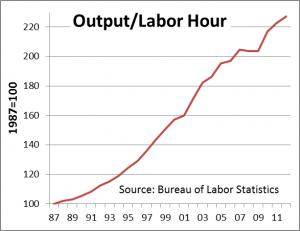 Workers cast adrift by technology. Last week we learned that the economy added 236,000 jobs in February. Better than a sharp stick in the eye, to be sure. But it still isn’t enough. Average job growth over the past six months has been about 190,000. At this rate, it will take the economy 5 years to absorb the increase in the ranks of the unemployed since 2007, plus new workers entering the labor force. And don’t forget the 8 million working part time who would prefer full time employment, 3.6 million more than in 2007.
Workers cast adrift by technology. Last week we learned that the economy added 236,000 jobs in February. Better than a sharp stick in the eye, to be sure. But it still isn’t enough. Average job growth over the past six months has been about 190,000. At this rate, it will take the economy 5 years to absorb the increase in the ranks of the unemployed since 2007, plus new workers entering the labor force. And don’t forget the 8 million working part time who would prefer full time employment, 3.6 million more than in 2007.
How do we square persistently tepid job growth with the other big economic news of the week, that the Dow Jones Industrial Average hit new highs? Why can corporate profits be strong while employment growth remains weak? This brief essay will address only one of the many reasons: This recovery has simply left many workers behind.
 The technological wonders that allow us to borrow a book without seeing a librarian, fuel our car without seeing a cashier, or book a meeting with a dozen people without seeing a secretary or making a single phone call have revolutionized the workplace. The trend is most apparent in the manufacturing sector. Just since 1987, the amount of “stuff” produced per labor hour has more than doubled.
The technological wonders that allow us to borrow a book without seeing a librarian, fuel our car without seeing a cashier, or book a meeting with a dozen people without seeing a secretary or making a single phone call have revolutionized the workplace. The trend is most apparent in the manufacturing sector. Just since 1987, the amount of “stuff” produced per labor hour has more than doubled.
Each technological advance renders another occupation obsolete. The trend is not limited to manufacturing. Many repetitive legal tasks can now be done by software, speeding the work of paralegals and new associate attorneys. “Speeding the work” means that we need fewer of them to accomplish the same tasks. TurboTax and its competitors have made it easier to file your taxes without the aid of an accountant. Technology has also exposed local labor to global competition. Radiologists in Chennai or Shanghai can interpret X-rays as easily as a radiologist on site at our local hospital.
Research confirms what we would conclude from observation: Recessions accelerate the speed at which technology replaces labor[*]. Firms cut jobs when sales falter and cost cutting spurs investment in labor saving innovation. As a consequence, many of the jobs don’t come back when sales improve. The workers who had filled these jobs have been cast adrift—what they know is no longer needed by our economy.
Jobs left unfilled? Yet businesses report that some positions remain chronically unfilled as applicants lack the requisite skills. In a perfect world, workers whose jobs have been lost to automation or offshoring would smoothly transition to new positions, with training available to help them prepare.
The real world doesn’t work this well. Neither the knowledge of the need nor the training to meet is always available. This is where community colleges play a critical role. In our community, the Economic Development and Innovative Workforce Services division of Monroe Community College was created specifically to address the training and workforce needs of the region from both a business and individual worker perspective.
Skills needs survey. In partnership with the Rochester Business Journal and the Center for Governmental Research, MCC is conducting a survey of local business to identify chronically unfilled positions in the Rochester area economy. In keeping with its mission, MCC will use the data from this survey to inform training programs that will specifically address local worker pipeline deficits faced by industry, and help put displaced workers back to work. As a major contributor to the Workforce Development initiative of the Finger Lakes Regional Economic Development Council, the policy implications raised by the survey will inform the Council’s workforce development strategy. If your business is contacted, please take a few minutes to respond. In a hypercompetitive global economy, investments in our workforce will make a lasting difference to our economy.
[*] See Nir Jaimovich and Henry E. SiuNir. The Trend is the Cycle: Job Polarization and Jobless Recoveries. March 31, 2012. http://goo.gl/pIB9X